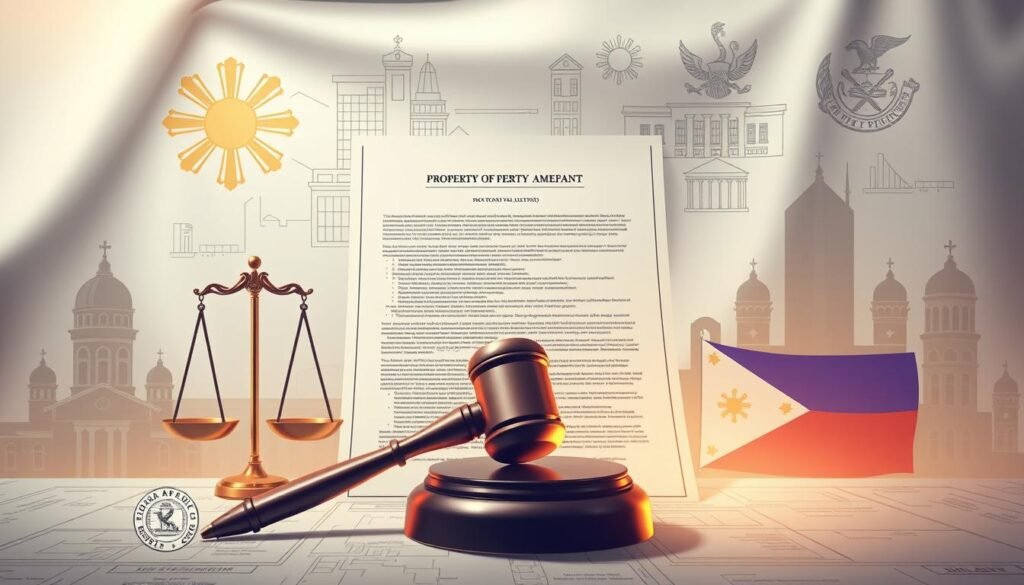Did you know that the Philippines has a rich history of property rights that dates back centuries? Long before modern legal frameworks, ancient Filipino societies had their own systems for managing valuable assets. These systems were deeply rooted in cultural practices and community values.
In traditional Filipino communities, property was not just about land or possessions. It included intangible assets like fishing rights, hunting grounds, and even spiritual connections to ancestral domains. These rights were often shared among families or clans, reflecting a collective approach to ownership.
Over time, these ancient practices evolved. Spanish colonization introduced new legal concepts, blending them with existing traditions. Today, the Philippines continues to balance historical customs with modern property law, ensuring that rights are protected in a changing world.
Understanding this evolution is crucial. It highlights how cultural and legal changes have shaped the way Filipinos view ownership. By exploring these concepts, we gain insight into the foundations of today’s property rights systems.
Key Takeaways
- Ancient Filipino societies had unique systems for managing property rights.
- Property included both tangible and intangible assets, like fishing rights and ancestral domains.
- Spanish colonization introduced new legal concepts that blended with traditional practices.
- Modern Philippine property law balances historical customs with contemporary needs.
- Understanding these concepts provides insight into the evolution of property rights in the Philippines.
Introduction to Property and Ownership in the Philippines
In the Philippines, ownership is deeply tied to both legal frameworks and cultural heritage. This unique blend shapes how individuals and entities control assets today. Understanding these concepts is key to navigating the country’s ownership systems.
Modern law defines ownership as the legal control over assets, whether tangible or intangible. Real assets include land and buildings, while personal assets cover items like vehicles and furniture. These definitions are rooted in the Civil Code of the Philippines, which governs ownership rights.

Individuals and entities play a crucial role as owners. Their rights are codified by law, ensuring protection and clarity. For example, a person can own land, but they must follow legal processes to transfer or sell it. This balance of rights and responsibilities is essential for maintaining order.
Cultural heritage also influences modern ownership practices. Traditional values, like communal land use, still resonate in many communities. These practices highlight the importance of shared resources and collective decision-making.
To better understand ownership in the Philippines, it’s helpful to explore its legal and cultural foundations. Below is a table summarizing key aspects of ownership:
| Aspect | Description |
|---|---|
| Real Assets | Land, buildings, and other immovable items. |
| Personal Assets | Vehicles, furniture, and other movable items. |
| Legal Framework | Governed by the Civil Code of the Philippines. |
| Cultural Influence | Shared resources and communal practices. |
This overview sets the stage for exploring historical perspectives and traditional systems. By understanding these foundations, we gain insight into how ownership has evolved in the Philippines.
Historical Perspectives on Property in the Philippines
Long before modern laws, land use in the Philippines was governed by indigenous traditions. These practices were deeply rooted in community values and collective decision-making. Land was not just a resource but a shared asset tied to ancestral domains and cultural identity.
In pre-colonial times, indigenous communities managed land through communal systems. Families or clans often held rights to specific areas for farming, hunting, or fishing. These practices ensured equitable access and sustainable use of resources.
Spanish colonization introduced drastic changes. The encomienda system granted large tracts of land to Spanish elites and the Catholic Church. This feudal system displaced many Filipinos, forcing them to work as tenants on lands they once freely used.
Colonial laws contrasted sharply with indigenous practices. While pre-colonial systems emphasized shared ownership, Spanish rule prioritized individual control. This shift laid the foundation for modern land ownership patterns in the Philippines.
Key moments in history further shaped land rights. The American occupation introduced urban planning concepts, while post-war reconstruction spurred housing developments. These changes reflected evolving societal needs and legal interpretations.
Today, the Philippines continues to balance historical customs with modern law. Understanding this evolution offers valuable insights into the country’s complex relationship with land and ownership.
Ancient Filipino Views on Land and Community Ownership
Early Filipino communities viewed land as a sacred connection to their ancestors and culture. It was not just a physical resource but a symbol of identity and heritage. This deep reverence shaped their approach to ownership, emphasizing collective stewardship over individual control.

Cultural Significance of Land in Early Societies
For ancient Filipinos, land held immense value as a marker of social status and heritage. It was often tied to ancestral domains, reflecting a spiritual bond with their forebears. Communities relied on shared resources like farming plots, hunting grounds, and fishing areas, ensuring equitable access for all.
This communal approach fostered a sense of unity and identity. Land was not just a means of survival but a form of cultural expression. It reinforced the idea that everyone had a stake in preserving their shared legacy.
Traditional Practices and Inheritance Customs
Inheritance customs in early Filipino societies were designed to maintain balance and fairness. Land was passed down through generations, often within families or clans. This ensured that resources remained within the community, preserving their interest in collective well-being.
Traditional practices also included rituals to honor the land’s spiritual significance. These customs highlighted the belief that land was a shared responsibility, not just an individual asset. Such practices ensured that resources were used sustainably and respectfully.
Today, these ancient views continue to influence modern attitudes toward land and ownership. They remind us of the importance of balancing individual rights with community value and shared stewardship.
Philosophical Foundations of Property Concepts
Philosophical ideas have long shaped how societies define ownership and control over resources. These theories provide the backbone for modern concepts, offering insights into why certain rights exist and how they are justified.

Effort, Labor, and the Right to Use Land
One of the most influential theories comes from John Locke, who argued that mixing labor with natural resources creates a right to ownership. This idea, known as the labor theory of property, suggests that effort justifies control over land or goods.
For example, if someone cultivates a piece of land, they have a case for claiming it as their own. This principle has shaped legal systems worldwide, emphasizing the role of individual effort in establishing rights.
Scarcity and Exclusivity in Property Theory
Another key concept is scarcity, which justifies exclusive ownership. When resources are limited, controlling access ensures they are used efficiently. This idea is central to many economic and legal frameworks.
Philosophers like Benjamin Tucker have debated whether effort or scarcity should take precedence in assigning rights. These discussions highlight the complexity of defining ownership in different contexts.
Understanding these theories helps clarify modern debates. For instance, legal arguments often reference Locke’s ideas, while economic policies rely on scarcity principles. Together, they form a critical part of how we view and manage resources today.
Labor and Scarcity: The Dual Pillars of Property Theory
Labor and scarcity are fundamental to how societies justify control over resources. These two concepts have shaped ownership theories for centuries, influencing both legal systems and economic principles.
Effort plays a critical role in establishing rights. When individuals invest labor into resources, they create a point of justification for ownership. For example, cultivating land or building structures often leads to claims over those assets. This idea, rooted in John Locke’s theories, remains relevant today.

Scarcity reinforces the need for exclusive control. When resources are limited, managing access ensures efficient use. This principle is evident in modern systems like tax policies, which regulate ownership to balance societal needs.
Historical examples highlight the dual impact of these pillars. In early societies, communal land use ensured equitable access. However, as populations grew, scarcity led to stricter ownership rules. Modern economies continue to reflect this balance, valuing both effort and resource limitations.
Practical implications include how property is valued. Assets requiring significant labor or located in scarce areas often command higher prices. This valuation aligns with broader economic principles, linking ownership to wealth creation and distribution.
Understanding labor and scarcity provides insight into modern ownership systems. These concepts remain central to debates over rights, ensuring that resources are managed fairly and efficiently.
Economic Perspectives on Property Rights
Economic theories have long shaped how societies view ownership and its role in development. From land to homes, assets are not just personal possessions but drivers of economic growth. Understanding this perspective helps explain why ownership systems are central to modern economies.

Property as an Economic Asset
Ownership is often seen as a form of capital. Assets like land and homes can generate income through rent, sale, or development. This transforms them into tools for wealth creation. For example, real estate investments can boost local economies by creating jobs and increasing value in communities.
Adam Smith’s theories highlight how private ownership encourages individuals to improve their assets. This leads to capital improvement and economic progress. When people have secure rights, they are more likely to invest in their home or land, benefiting both themselves and society.
Impact on Wealth Generation and Development
Private ownership plays a key role in economic development. It provides incentives for individuals to use resources efficiently, driving growth. Studies show that secure titles increase land values by up to 36%, as seen in the Brazilian Amazon.
Wealth distribution is another critical aspect. Ownership allows individuals to build equity, which can be passed down through generations. This creates opportunities for upward mobility and reduces economic inequality. However, the government must ensure fair access to ownership to prevent monopolies.
Real estate investments also have a transformative impact. For instance, legal titles improved housing quality by 37% in a Buenos Aires slum. Such examples demonstrate how ownership can uplift communities and stimulate local economies.
| Aspect | Impact |
|---|---|
| Private Ownership | Encourages investment and capital improvement. |
| Wealth Distribution | Builds equity and reduces economic inequality. |
| Real Estate Investments | Boosts local economies and improves housing quality. |
By understanding these economic perspectives, we see how ownership systems shape societies. They not only drive growth but also ensure that resources are used sustainably and equitably.
Legal Framework: Property Law in the Philippines
The legal framework in the Philippines defines ownership with precision and clarity. Rooted in the Civil Code, it outlines rights and limitations for both real and personal assets. This system ensures that ownership is protected and disputes are resolved fairly.
Philippine property law governs a wide range of assets, from land and buildings to movable items like vehicles. For example, the regulation of a car involves specific legal processes, ensuring that ownership is properly documented and transferred. This clarity helps prevent conflicts and ensures accountability.

Legal definitions play a crucial role in clarifying ownership rights. Terms like “real property” and “personal property” are clearly outlined in statutory texts. This precision helps individuals and entities understand their rights and responsibilities under the law.
Recent reforms have further strengthened the legal framework. For instance, the Real Property Valuation and Assessment Reform Act standardizes property appraisal, ensuring fairness in taxation. These updates reflect the government’s commitment to modernizing ownership systems.
Below is a table summarizing key aspects of Philippine property law:
| Aspect | Description |
|---|---|
| Real Property | Land, buildings, and other immovable assets. |
| Personal Property | Movable items like vehicles, furniture, and equipment. |
| Legal Definitions | Clear terms outlined in the Civil Code. |
| Recent Reforms | Updates like the Real Property Valuation Act. |
Understanding this legal framework is essential for navigating ownership in the Philippines. It ensures that rights are protected and resources are managed efficiently.
Comparing Real Property and Personal Property
Ownership in the Philippines is divided into two main categories: real and personal assets. These classifications are essential for understanding how rights, taxation, and legal disputes are handled. Real assets include land and permanent structures, while personal assets cover movable items like vehicles and furniture.

Understanding Real Estate and its Boundaries
Real property refers to land and anything permanently attached to it, such as buildings or fixtures. For example, a house is considered real property because it is fixed to the land. This classification also includes rights like possession, sale, and lease, which are governed by legal agreements.
Real property often appreciates in value over time, making it a significant investment. However, it is subject to property taxes, which are calculated based on the amount of land and improvements. Understanding these boundaries is crucial for managing ownership effectively.
Key Distinctions in Personal Possessions
Personal property, on the other hand, includes movable items like cars, furniture, and equipment. Unlike real property, these assets typically depreciate in value. For instance, a vehicle is classified as personal property and can be used as collateral for loans, similar to how a house secures a mortgage.
Legal treatments for personal property differ significantly. Transferring ownership is often simpler, requiring only a sales agreement. However, certain items may incur sales or use taxes, depending on their amount and value.
These distinctions have practical implications for ownership, taxation, and legal disputes. By understanding the differences, individuals can make informed decisions about their assets.
Government Ownership vs. Private Property
Government and private ownership play distinct roles in shaping how assets are managed and used. While private ownership focuses on individual rights, government ownership serves a broader purpose for public benefit. Understanding these differences is key to navigating legal and economic systems.
One key concept is eminent domain, which allows the government to acquire private land for public use. This ensures that essential infrastructure, like roads and schools, can be developed. However, fair compensation is required, protecting private owners’ rights.

Government-owned assets often include public buildings, parks, and utilities. These are managed for communal use, ensuring accessibility for all. In contrast, private estates focus on individual or corporate interests, such as residential homes or commercial buildings.
Legal protections also differ. Private ownership is safeguarded by titles and agreements, ensuring exclusive rights. Government assets, on the other hand, are protected by laws that prioritize public welfare. For example, public land cannot be sold without meeting specific criteria.
Here are some key distinctions between government and private ownership:
- Government assets serve a public purpose, while private estates focus on individual or corporate interests.
- Eminent domain allows the government to acquire private land for essential infrastructure.
- Legal titles protect private ownership, while public assets are governed by laws prioritizing communal welfare.
- Examples include public buildings like schools and private estates like residential homes.
For a deeper dive into the distinctions between public and private ownership, visit this detailed comparison.
Understanding these differences helps clarify how resources are allocated and protected. Whether it’s a government building or a private estate, each type of ownership plays a vital role in shaping society.
Intellectual Property: Traditional Concepts to Modern Realities
Intellectual property has transformed from ancient cultural traditions to modern legal protections. Unlike physical assets, it encompasses intangible creations like ideas, designs, and artistic works. This evolution reflects the changing needs of societies, blending historical practices with contemporary legal frameworks.

In traditional societies, cultural artifacts and creative works were often seen as communal assets. For example, indigenous communities shared knowledge and artistic expressions within their groups. This collective approach ensured that cultural heritage was preserved and passed down through generations.
Evolution of Intellectual Rights in Cultural Artifacts
The rise of the printing press in the 15th century marked a turning point. It necessitated the development of copyright laws to protect authors and publishers. Similarly, the industrial revolution led to the establishment of patent systems, encouraging inventors to share their innovations.
Today, intellectual property is protected through mechanisms like patents, copyrights, and trademarks. These legal tools ensure that creators and inventors can benefit from their work. For instance, a patent grants exclusive rights to an invention for a specific year, while copyright protects artistic expressions.
Modern systems also address challenges like online piracy and digital content protection. The digital age has introduced new complexities, requiring updated legal frameworks. Organizations like the World Intellectual Property Organization (WIPO) play a crucial role in harmonizing global standards.
Intellectual property contributes significantly to economic and cultural development. It stimulates investment in research and innovation, driving progress. For example, patents encourage the development of new technologies, while copyrights support creative industries.
Understanding the contrast between traditional and modern intellectual property systems is essential. While traditional practices emphasized communal ownership, modern laws focus on individual rights. This shift reflects broader societal changes and the need for legal clarity.
For a deeper dive into the evolution of intellectual property, explore this detailed analysis.
From Ancient Traditions to Modern Land Reforms
From communal stewardship to individual rights, land ownership in the Philippines has evolved significantly. Ancient Filipino societies viewed land as a shared resource, tied to ancestral domains and cultural identity. This collective approach ensured equitable access and sustainable use of resources.
Colonial history played a pivotal role in shaping modern property laws. Spanish rule introduced the encomienda system, which concentrated land ownership among elites. This shift from communal to individual control laid the foundation for today’s legal frameworks.
Land reform policies in the 20th century aimed to address historical inequalities. The Comprehensive Agrarian Reform Program (CARP) redistributed land to farmers, promoting social equity and economic development. These reforms reflect the integration of ancient wisdom with modern legal principles.
Case studies highlight the impact of these changes. For example, the redistribution of land in Hacienda Luisita transformed the lives of thousands of farmers. Such initiatives demonstrate the socio-economic benefits of equitable land ownership.
The evolution of land ownership in the Philippines underscores the importance of balancing tradition with progress. As the country continues to refine its policies, the lessons of the past remain a guiding force. For a deeper dive into the history of land reform, explore this detailed analysis.
The Influence of Colonialism on Property Concepts
Colonial rule reshaped the way Filipinos viewed ownership and control over their resources. Before European powers arrived, traditional systems emphasized communal stewardship. However, colonial impositions introduced new legal frameworks that prioritized individual control and commercial use.
Colonial Impositions on Local Ownership
Spanish colonization brought significant changes to land ownership in the Philippines. The encomienda system granted large tracts of land to Spanish elites and the Catholic Church. This system displaced many indigenous communities, forcing them to work as tenants on lands they once freely used.
Colonial laws often conflicted with traditional practices. For example, indigenous systems emphasized shared access to resources like fishing grounds and farming plots. In contrast, Spanish laws introduced private ownership, treating land as a commercial estate rather than a communal asset.
Transitioning to Post-Colonial Legal Systems
After gaining independence, the Philippines faced the challenge of reconciling colonial laws with traditional values. Post-colonial legal frameworks sought to address historical inequalities while preserving cultural heritage. For instance, the Comprehensive Agrarian Reform Program (CARP) redistributed land to farmers, promoting social equity.
However, the transition was not without challenges. Conflicts arose between traditional rights and modern legal interpretations. For example, ancestral domains often overlapped with areas designated for development, leading to disputes over resource allocation.
Colonial impositions continue to influence modern property legislation. For a deeper understanding of this historical context, explore this detailed analysis.
| Colonial Imposition | Impact on Local Ownership |
|---|---|
| Encomienda System | Concentrated land ownership among elites, displacing indigenous communities. |
| Private Ownership Laws | Replaced communal systems, treating land as a commercial asset. |
| Post-Colonial Reforms | Redistributed land to address historical inequalities. |
Taxation and Regulation in Philippine Property Law
Taxation and regulation play a pivotal role in shaping how ownership is managed in the Philippines. These mechanisms ensure that the state maintains control over resources while protecting the rights of individuals. Understanding these systems is essential for navigating ownership in the country.
Property taxes are assessed based on factors like location, size, and use. For example, land in urban areas often has higher valuations than rural areas. The state uses these taxes to fund public services and infrastructure, ensuring equitable development.
Government regulation also plays a key role in maintaining property standards. Laws ensure that buildings meet safety codes and that land is used sustainably. This balance between individual rights and public welfare is a cornerstone of Philippine property law.
Legal frameworks govern taxation and revenue generation. For instance, the Real Property Valuation and Assessment Reform Act standardizes appraisal processes, ensuring fairness. These laws provide clarity and prevent disputes over valuations.
Current tax laws impact both private and government-owned assets. For example, private landowners pay annual real property taxes, while government assets are exempt. This distinction ensures that public resources are used for communal benefit.
Here’s a summary of key aspects of taxation and regulation:
| Aspect | Description |
|---|---|
| Property Tax Assessment | Based on location, size, and use of land. |
| Government Regulation | Ensures safety and sustainability in land use. |
| Legal Frameworks | Standardize appraisal and taxation processes. |
| Impact on Ownership | Balances individual rights with public welfare. |
By understanding these systems, individuals can better navigate the complexities of ownership in the Philippines. Taxation and regulation ensure that resources are managed fairly and efficiently, benefiting both the state and its citizens.
Contemporary Issues in Property Ownership
Modern property ownership in the Philippines faces a range of legal and societal challenges. From disputes over land titles to conflicts involving ancestral domains, these issues highlight the complexities of managing assets in a rapidly evolving landscape.
One of the most pressing concerns is the lack of clear documentation for many properties. This often leads to legal battles over possession and ownership. For example, heirs’ properties, where land is passed down without formal titles, are a common source of conflict.
Legal Disputes and Resolution Mechanisms
Disputes over property rights often arise due to unclear boundaries or overlapping claims. In many cases, these conflicts involve possession of land that has been in families for generations but lacks formal documentation. Legal mechanisms like mediation and court proceedings are essential for resolving such issues.
Recent reforms aim to address these challenges. For instance, the Uniform Partition of Heirs’ Property Act (UPHPA) provides a framework for dividing inherited land fairly. This helps prevent disputes and ensures that all heirs receive their rightful share.
Another significant issue is the impact of urbanization on property ownership. As cities expand, land values rise, leading to increased conflicts over possession and use. Legal frameworks must adapt to these changes to ensure fairness and clarity.
Reform proposals are also focusing on improving transparency in property transactions. Clearer rules and better documentation can reduce disputes and protect the rights of all parties involved. For example, digital land registries are being introduced to streamline the process of verifying ownership.
Understanding these contemporary issues is crucial for navigating property ownership in the Philippines. For more insights into how global trends are affecting real estate, explore this detailed analysis.
Ancient Filipino Property: Lessons for Modern Practices
Ancient Filipino practices offer timeless lessons for modern property management. These traditions, rooted in community values and sustainable resource use, provide a blueprint for balancing individual rights with collective well-being. By integrating traditional wisdom into current legal frameworks, we can create more equitable and efficient systems.
Integrating Traditional Wisdom with Current Laws
One key lesson from ancient Filipino practices is the importance of communal stewardship. Early societies viewed land as a shared resource, ensuring equitable access for all. This approach contrasts with modern systems that often prioritize individual ownership. However, blending these concepts can lead to more inclusive policies.
For example, the traditional bahay kubo design emphasizes sustainability and adaptability. These principles can inspire modern architecture, particularly in urban areas like New York, where space is limited. By incorporating eco-friendly materials and shared spaces, we can create homes that reflect both tradition and innovation.
Another valuable insight is the role of cultural heritage in shaping ownership systems. Ancient practices like communal fishing rights and ancestral domain stewardship highlight the importance of preserving cultural identity. Modern laws can draw from these traditions to protect indigenous communities and their resources.
Actionable Insights for Policymakers and Owners
Policymakers can learn from the ancient Filipino approach to resource management. For instance, implementing community-based land use plans can ensure sustainable development. Owners, too, can adopt practices like shared spaces, which foster a sense of belonging and cooperation.
Here are some key lessons from ancient Filipino property practices:
- Communal stewardship ensures equitable access to resources.
- Sustainable designs, like the bahay kubo, inspire modern architecture.
- Cultural heritage plays a vital role in shaping ownership systems.
- Shared spaces foster community and cooperation.
For a deeper understanding of how traditional Filipino architecture has evolved, explore this detailed analysis.
| Ancient Practice | Modern Application |
|---|---|
| Communal Land Use | Community-based land use plans. |
| Sustainable Design | Eco-friendly materials in urban architecture. |
| Cultural Preservation | Protecting indigenous rights and resources. |
| Shared Spaces | Fostering community in modern developments. |
By blending ancient wisdom with modern laws, we can create ownership systems that respect cultural heritage while meeting contemporary needs. These lessons remind us that the past holds valuable insights for shaping a better future.
Conclusion
The journey of ownership concepts in the Philippines reflects a blend of tradition and modernity. From ancient communal practices to today’s legal frameworks, the evolution highlights the importance of cultural heritage in shaping new systems. Early Filipino societies valued shared resources, while colonial and modern influences introduced individual rights and legal clarity.
Understanding this history is crucial for addressing contemporary challenges. The contrasts between traditional and modern practices offer valuable lessons. For instance, the idea of communal stewardship can inspire more inclusive policies, ensuring equitable access to resources.
As the Philippines continues to evolve, integrating these lessons into future reforms is essential. By balancing tradition with progress, the country can create ownership systems that respect cultural identity while meeting modern needs. For further insights, explore this detailed analysis on the evolution of ownership concepts.
FAQ
What were the ancient Filipino concepts of land ownership?
Early Filipino societies viewed land as a communal resource, often shared among community members. Ownership was tied to use and labor, reflecting a deep connection to the land and its cultural significance.
How did traditional inheritance customs work in ancient Philippines?
Inheritance was often passed down through family lines, with land and resources distributed based on customs and community agreements. These practices ensured continuity and fairness within the group.
What role did labor play in ancient property theories?
Labor was central to the idea of ownership. Those who worked the land or developed resources were seen as having a rightful claim to them, emphasizing effort and contribution.
How did colonialism affect property concepts in the Philippines?
Colonial rule introduced foreign systems of ownership, often displacing traditional practices. This led to conflicts over land and resources, reshaping local views on possession and control.
What is the difference between real and personal property in the Philippines?
Real property refers to land and permanent structures, while personal property includes movable items like vehicles or furniture. Each type has distinct legal implications and boundaries.
How does the Philippine government regulate private ownership?
The government enforces laws and taxes to manage ownership rights. This includes zoning regulations, land reforms, and policies aimed at balancing private and public interests.
What are some contemporary issues in Philippine property ownership?
Modern challenges include legal disputes over land, the impact of urbanization, and the need for sustainable development. Resolving these issues often requires innovative solutions and fair policies.
How can ancient Filipino property concepts inform modern practices?
Traditional wisdom, such as communal sharing and respect for labor, can inspire equitable and sustainable approaches to ownership today. Integrating these ideas with current laws may foster harmony and progress.
Source Links
- History of the Philippines | People, Spain, United States, Revolution, Map, & Facts | Britannica
- Ancestral domain
- The Regalian Doctrine and Its Implications Under Philippine Law — Respicio & Co.
- Understanding Property Rights and Inheritance Under Philippine Law — Respicio & Co.
- Classification of Property | Property | PROPERTY, OWNERSHIP, AND ITS MODIFICATIONS
- Real Estate in the Philippines: A Historical Perspective
- From Spanish Haciendas to Condominium Living: Tracing the Evolution of Real Estate in the Philippines
- The PH Real Estate History and its Lessons | Crown Asia
- Indigenous Peoples in the Philippines: Continuing Struggle
- Indigenous Peoples, Ancestral Lands and Human Rights in the Philippines
- Land Reform / Réforme agraire / Reforma agraria /
- Philosophical Foundations of Property Law
- Property | Internet Encyclopedia of Philosophy
- Property and Ownership
- Scarcity, Property Rights, Irresponsibility: How Intellectual Property Deals with Neglected Tropical Diseases
- Property Rights – Econlib
- No title found
- Legal Framework and Remedies for Real Property Disputes in the Philippines — Respicio & Co.
- Navigating the Philippine real estate legal landscape | Law.asia
- Understanding Property Rights in the Philippines
- What Is Real Property? Definition and Types of Properties
- Real Property vs Personal Property: Clarifying Property Rights — Vintti
- Real Property vs. Personal Property: Difference and Types – NerdWallet
- Government-Owned Property: Definition, Example and Property Types
- Private property
- What Are Property Rights and Why Do They Matter?
- Intellectual Property: Protecting Innovation and Creativity
- CIEL
- THE UNIVERSALITY OF INTELLECTUAL PROPERTY RIGHTS:
- Land Reform: A (Very) Brief History | Watershed Sentinel
- Land Reform in the Twenty-First Century: New Challenges, New Responses
- No title found
- No title found
- Real Estate Guide Philippines
- UNDERSTANDING “SOLO TITLE” IN PHILIPPINE PROPERTY LAW — Respicio & Co.
- Why Heirs’ Property is a Problem for Vacancy and Abandonment | Center for Community Progress
- Land and Property Ownership: A Story Beneath Our Feet
- The makings of a modern Filipino home
- Traditional vs. Modern Filipino Architecture – Richest Philippines
- Conclusion: Property’s Placelessness
- Conclusion – Property Law
- Conclusion – Thinking about Property

